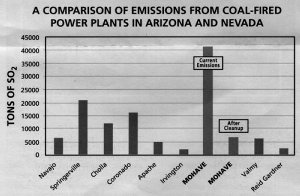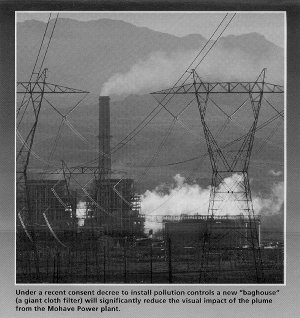Cleaner Air On Horizon At Both Ends Of Canyon
MOHAVE CLEAN UP AGREEMENT REACHED & TRUST SEES COMPLETION OF NAVAJO PLANT CLEAN UP
The Trust's air quality program has just scored a second major vistory. This October we signed a consent decree requiring the owners of the Mohave power plant in Laughlin, Nevada to dramatically reduce the plant's emissions by installing pollution control equipment. The decree was signed two weeks before the for final dedication of the new scrubbers at the Navajo power plant in Page, Arizona, installed because of an earlier battle led by the Trust to protect air quality at the Grand Canyon.
"This is a major victory for the environment and the Grand Canyon," said Trust President Geoff Barnard. "In fact, October is a banner month for the Grand Canyon's skies." The Navajo plant clean up culminated in a dedication ceremony on October 14 of a $420 million sulfur dioxide scrubber. The Grand Canyon Trust negotiated an agreement with the Salt River Project to cut sulfur dioxide emissions at the coal-fired power plant by 90 percent in 1991. The Navajo victory marks the first time a polluting source has been cleaned up because of its impact on visibility at a national park. The Navajo Generating Station has been a major source of air pollution affecting the gorgeous views at Grand Canyon. Lee's Ferry and the park's northeast boundary are just a few miles from the plant.
The massive, 1,580-megawatt Mohave plant sits just 75 miles west of Grand Canyon National Park. Mohave emits 40,000 tons of sulfur dioxide annually. Under the terms of the consent decree, the owners of the Mohave plant have agreed to reduce sulfur dioxide emissions by 85 percent, resulting in the removal of about 34,000 tons of sulfur dioxide from the region's air annually. The have also agreed to meet a more stringent opacity limit, which will virtually eliminate the tremendous clouds of soot and smoke that the plant currently emits. Also, nitrogen oxide emissions will be reduced by 25 to 40 percent. Construction of the pollution controls will take approximately three and one-half years, with the plant coming into compliance with the decree's new, tougher standards by the end of 2005. The emission limits in the decree cannot be relaxed in the future.
The consent decree was lodged in Federal Court in Las Vegas on October 6, 1999. The Environmental Protection Agency, as the federal agency that enforces the Clean Air Act, has 45 days to comment on the decree. After the judge receives EPA's comments, or after the 45-day comment period has expired, the judge is free to sign the decree. Once the decree is signed, it becomes a court-enforceable document. The decree remains in effect until, at a minimum, the plant has been in compliance with the decree's emission limits for one year. During the life of the decree we will
receive quarterly emission reports. This will ensure that Mohave's owners are not violating the interim emission limits that apply before the new controls are installed.
"Cleaning up these two plants, one at each end of the Grand Canyon, will pull more than 100,000 tons of sulfur dioxide out of the air over the Grannd Canyon," said Rick Moore, air quality officer for the Grand Canyon Trust. "But there is still much work left to do if we are to control and reduce the soup of pollutants obscuring views across the Colorado Plateau and at Grand Canyon
National Park."
The decree was a result of persistence and dedication by the Grand Canyon Trust and attorney Reed Zars during 13 months of negotiations. This work ensures significant air pollution cleanup for Mohave Valley residents and at the west end of Grand Canyon National Park. The agreement ensures that the Mohave plant will not operate past 2005 without air pollution controls.
"The settlement is a compromise between the date the litigants (led by the Trust) wanted which was sooner than 2005 and what some of the owners wanted which would have been infinity," said S. David Freeman, general manager of the Los Angeles Department of Water and Power, in a Wall Street Journal interview.
Thanks to our supporters for making this happen!


click image to enlarge
|
 click image to enlarge
click image to enlarge
SUMMARY OF THE MOHAVE POLLUTION CONTROL AGREEMENT
- Sulfur dioxide (SO2) contributes to haze in the Grand Canyon. The decree requires SO2 to be reduced by a minimum of 85 percent, and also limits the plant to emitting no more than .150 pounds of SO2, per million BTUs. (The second limit is important to ensure that burning higher sulfur coal will not erode gains achieved by the 85 percent reduction limit.)
- Emission of fine particles, which can be unhealthful to breathe, will be significantly reduced. A baghouse (a gigantic fabric filter) will ensure that emissions from the stack do not exceed 20 percent opacity. (Zero opacity is clear while 100 percent opacity completely blocks light.)
- New burners will he installed in the boilers to reduce the plant's emissions of nitrogen oxides by 25 to 40 percent. Nitrogen oxides are another significant contributor to haze over the Grand Canyon.
- If Mohave is sold, the new owners are bound by the consent decree and will be required to install the controls no later than three years and three months after buying the plant.
- The plant's owners have determined that the cost of the pollution controls - estimated at $300 million - will not significantly impact the long-term economic viability of the plant.
- Emission limits in the decree will be included in the plant's operating permit and in the portion of the Nevada State Implementation Plan (SIP) applicable to Mohave. The decree's limits cannot be reduced by future regulatory action by state or local governments.
|
|


